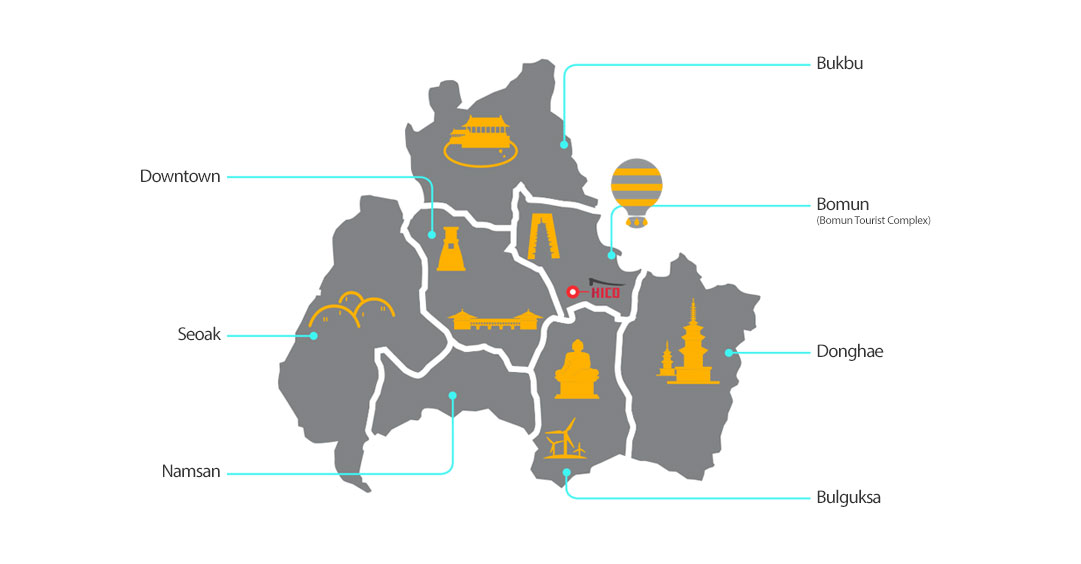
Gyeongju can be divided into 7 distinct tourist zones - Downtown, Bomun, Bulguksa, Namsan, Donghae, Seoak, and Bukbu. Each zone has its own unique appeal which allows conference organizers to plan a wide variety of programs to suit different themes and purposes.

Past and present coexist in downtown Gyeongju where palace grounds, burial sites, ancient ruins, and Buddhist temples can still be found among scenes of urban life. The mythology surrounding the founding monarchs of the Silla can be traced to archeological sites located throughout the area, making it a good starting point for visitors interested in tracing Silla’s history. Of the five areas that make up the Gyeongju Historic Area (designated a UNESCO World Heritage site in 2000), Wolseong (Wolseong Palace Site) Belt, Tumuli Park Belt, and Hwangnyongsa (Hwangnyongsa Temple Site) Belt are located here.

A scenic man-made lake lies at the center of this zone which covers over 8.5 million square meters of beautifully landscaped land. The Bomun Tourist Complex serves as a comprehensive recreational development with luxury hotels, condotels, golf courses, and theme parks. It is also home to the Sanseong Fortress Belt, which forms part of the Gyeongju Historic Area (designated a UNESCO World Heritage Site in 2000).

The Bulguksa zone includes Tohamsan Mountain, revered during Silla as one of the five sacred mountains that protected the kingdom. Its slopes were the site of ritualistic ceremonies during the Silla period and are still home to Bulguksa Temple and Seokguram Grotto (added to the UNESCO World Heritage list in 1995). The sites date back to the 8th century and have come to represent the epitome of Unified Silla culture.

It is said that Silla’s history begins and ends in Namsan. The area includes Najeong Well where Silla’s founder Bak Hyeokgeose was born as well as the remains of Poseokjeong Pavilion where kings hosted lavish banquets in the waning days of Unified Silla. Also in this area is the Mount Namsan Belt of the UNESCO designated Gyeongju Historic Areas with its remarkable concentration of sites and artifacts, including the ruins of over temples, stone Buddhas, and stone pagodas.

Donghae, meaning the East Sea, stretches out to include the Underwater Tomb of King Munmu who gave orders to be buried at sea so that he could come back as dragon to protect the kingdom. Other historical points of interest include the Gameunsaji Temple Site, Golgulsa Temple, and Girimsa Temple. Along the coastline, visitors can also find beaches, camping sites, seaside walking trails, sports facilities, and other recreational outlets.

Seoak is closely associated with Hwarang, the elite class of young warriors who led their kingdom into the Unified Silla era. The most famous of these warriors, General Kim Yushin, trained at Danseoksan Mountain in Seoak before going on to conquer Silla’s neighboring kingdoms with King Muyeol whose royal tomb is also located in this area. Other popular sites include the birthplace of Park Mog-wol who is considered the father of modern Korean poetry, the lotus ponds of Buunji, and Geumjangdae which offers the most breathtaking views in Gyeongju.

Bukbu remained a vital part of the Goryeo and Joseon dynasties that followed Silla. In addition to sacred Buddhist sites, the area contains Yongdamjeong, the birthplace of the founder of Cheondoism, a native Korean religion with roots in Neo-Confucianism. Confucian culture is also on display in Yangdong Village which was named a UNESCO World Heritage site along with Andong Hahoe Village in 2010.
